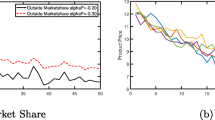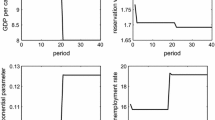Abstract
This paper precisely delineates the empirical content of consumer rationality in the following setting: Data are from a repeated cross section; unobserved heterogeneity is completely unrestricted; however, there are only two goods. Simple closed-form expressions determine whether (population level) data are consistent with these assumptions. Bounds on counterfactual distributions of demand, and parameters thereof, follow. A striking finding is that any rationalizable collection of cross-sectional distributions can be rationalized by pretending that the ordering of individual consumers on the budget line is maintained across budgets. Hence, this seemingly strong assumption does not tighten the bounds.

Similar content being viewed by others
Notes
The distribution \(G\) defines a random utility model; thus, \(\left\{ F_{t}\right\} _{t\in \mathcal {T}}\) is stochastically rationalizable iff it can arise as population distribution from some random utility model. In principle, the model could also be interpreted as describing single-agent stochastic choice, but our assumptions are geared to demand analysis with repeated cross sections.
Andreoni and Miller (2002) observe repeated choices by the same consumers in a sequence of linear budget sets with two goods. Rank invariance is frequently violated; one violation is visually apparent from comparing panels c and d of their Figure 2. We are not aware of direct tests of rank invariance outside the laboratory. This would require consumer panel data, which are rare; see Christensen (2014) for references and a discussion. That said, the heterogeneity of income effects estimated by Hoderlein et al. (2010) and Christensen (2014) would preclude rank invariance in two-good versions of their models.
For clarity, we here abstract from any measurement error or any other “\(\varepsilon _{it}\)” term that would induce violations of rank invariance in observed data even if it were a true feature of the distribution of preferences.
Recall that SARP excludes revealed preference cycles of arbitrary length. In this paper’s notation, call \(q(\mathbf {p}_{s},\mathbf {a})\) revealed preferred to \(q(\mathbf {p}_{t},\mathbf {a})\) if \(p_{s}^{1}\left( 1-p_{s}^{2}q( \mathbf {p}_{t},\mathbf {a})\right) /p_{s}^{1}+p_{s}^{2}q(\mathbf {p}_{t}, \mathbf {a})\le 1\), then there must not exist any finite length cycle of revealed preference in which at least one of the inequalities is strict.
This remark applies only to nonparametric revealed preference analysis along the lines of this paper, e.g., nonparametric extrapolation from data in Andreoni and Miller (2002). If one uses panel data to estimate more structured models, the panel dimension might certainly be useful. Also, a given panel data set might reveal violations of WARP. If one is willing to attribute them to data issues but wants to pose a well-defined extrapolation problem, one will have to “iron them out” in some manner; else, there will not exist a rationalizable joint distribution of choices over all budgets. Our remark then applies to the ironed out data.
See Hoderlein and Stoye (2014) for definitions of these concepts.
References
Afriat, S.: The construction of utility functions from expenditure data. Int. Econ. Re. 8, 67–77 (1967)
Afriat, S.: On a system of inequalities in demand analysis: an extension of the classical method. Int. Econ. Rev. 14, 460–472 (1973)
Andreoni, J., Miller, J.: Giving according to GARP: an experimental test of the consistency of preferences for altruism. Econometrica 70, 737–753 (2002)
Bandyopadhyay, T., Dasgupta, I., Pattanaik, P.K.: Demand aggregation and the weak axiom of stochastic revealed preference. J. Econ. Theory 107, 483–489 (2002)
Bandyopadhyay, T., Dasgupta, I., Pattanaik, P.K.: A general revealed preference theorem for stochastic demand behavior. Econ. Theory 23, 589–599 (2004)
Barberà, S., Pattanaik, P.K.: Falmagne and the rationalizability of stochastic choices in terms of random orderings. Econometrica 54, 707–715 (1986)
Beckert, W., Blundell, R.: Heterogeneity and the non-parametric analysis of consumer choice: conditions for invertibility. Rev. Econ. Stud. 75, 1069–1080 (2008)
Block, H., Marschak, J.: Random orderings and stochastic theories of response. In: Oklin, I., et al. (eds.) Contributions to Probability and Statistics. Stanford University Press, Stanford (1960)
Blundell, R., Browning, M., Cherchye, L., Crawford, I., de Rock, B., Vermeulen, F.: Sharp for SARP: nonparametric bounds on counterfactual demands. Am Econ J. Microecon. forthcoming (2014)
Blundell, R., Browning, M., Crawford, I.: Nonparametric Engel curves and revealed preference. Econometrica 71, 205–240 (2003)
Blundell, R., Browning, M., Crawford, I.: Best nonparametric bounds on demand responses. Econometrica 76, 1227–1262 (2008)
Blundell, R., Horowitz, J., Parey, M.: Measuring the price responsiveness of gasoline demand: economic shape restrictions and nonparametric demand estimation. Quant. Econ. 3, 29–51 (2012)
Blundell, R., Horowitz, J., Parey, M.: Nonparametric Estimation of a Heterogeneous Demand Function Under the Slutsky Inequality Restriction. CeMMAP working paper 54/13 (2013)
Blundell, R., Kristensen, D., Matzkin, R.L.: Bounding quantile demand functions using revealed preference inequalities. J. Econ. 179, 112–127 (2014)
Chernozhukov, V., Hansen, C.: An IV model of quantile treatment effects. Econometrica 73, 245–261 (2005)
Chernozhukov, V., Lee, S., Rosen, A.M.: Intersection bounds: estimation and inference. Econometrica 81, 667–737 (2013)
Christensen, M.: Heterogeneity in consumer demands and the income effect: evidence from panel data. Scand. J. Econ. 116, 335–355 (2014)
Cosaert, S., Demuynck, T.: Nonparametric Welfare and Demand Analysis with Unobserved Individual Heterogeneity. Maastricht University, Discussion Paper (2014)
Falmagne, J.-C.: A representation theorem for finite random scale systems. J. Math. Psychol. 18, 52–72 (1978)
Haag, B.R., Hoderlein, S., Pendakur, K.: Testing and imposing Slutsky symmetry in nonparametric demand systems. J. Econ. 153, 33–50 (2009)
Hausman, J., Newey, W.: Individual Heterogeneity and Average Welfare. CeMMAP working paper 34/13 (2013)
Hoderlein, S.: How many consumers are rational? J. Econ. 164, 294–309 (2011)
Hoderlein, S., Klemelä, J., Mammen, E.: Analyzing the random coefficient model nonparametrically. Econ. Theory 26, 804–837 (2010)
Hoderlein, S., Stoye, J.: Revealed preferences in a heterogeneous population. Rev. Econ. Stat. 96, 197–213 (2014)
Kawaguchi, K.: Nonparametric Test of Axioms of Revealed Stochastic Preference. Discussion paper, London School of Economics (2012)
Kitamura, Y., Stoye, J.: Nonparametric Analysis of Random Utility Models: Testing. CeMMAP working paper 36/13 (2013)
Lewbel, A.: Demand systems with and without errors. Am. Econ. Rev. 91, 611–618 (2001)
Manski, C.F.: Partial identification of counterfactual probabilities. Int. Econ. Rev. 48, 1393–1410 (2007)
Manski, C.F.: Identification of income–leisure preferences and evaluation of income tax policy. Quant. Econ. 5, 145–174 (2014)
Matzkin, R.: Heterogeneous choice. In: Blundell, R., Newey, W., Persson, T. (eds.) Advances in Econometrics: Proceedings of the 9th World Congress. Cambridge University Press, Cambridge (2006)
McFadden, D.: Revealed stochastic preference: a synthesis. Econ. Theory 26, 245–264 (2005)
McFadden, D., Richter, M.: Stochastic rationality and revealed stochastic preference. In: Chipman, J., McFadden, D., Richter, M. (eds.) Preferences, Uncertainty and Optimality: Essays in Honour of Leo Hurwicz. Westview Press, Boulder (1991)
Polisson, M., Quah, J.K.-H.: Revealed preference in a discrete consumption space. Am. Econ. J. Microecon. 5, 28–34 (2013)
Rose, H.: Consistency of preferences: the two-commodity case. Rev. Econ. Stud. 25, 124–125 (1958)
Stoye, J.: Partial identification of spread parameters. Quant. Econ. 1, 323–357 (2010)
Varian, H.: The nonparametric approach to demand analysis. Econometrica 50, 945–974 (1982)
Author information
Authors and Affiliations
Corresponding author
Additional information
Stoye gratefully acknowledges support through NSF Grant SES-1260980. We thank Chuck Manski and two anonymous referees for helpful comments but assume responsibility for any and all errors.
Rights and permissions
About this article
Cite this article
Hoderlein, S., Stoye, J. Testing stochastic rationality and predicting stochastic demand: the case of two goods. Econ Theory Bull 3, 313–328 (2015). https://doi.org/10.1007/s40505-014-0061-5
Received:
Accepted:
Published:
Issue Date:
DOI: https://doi.org/10.1007/s40505-014-0061-5




